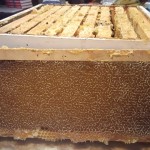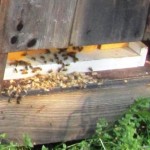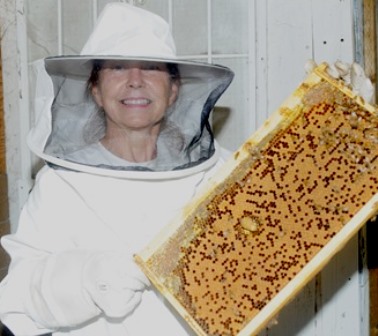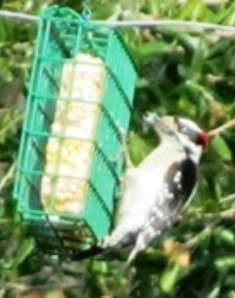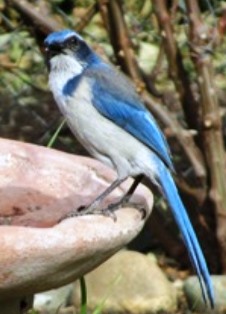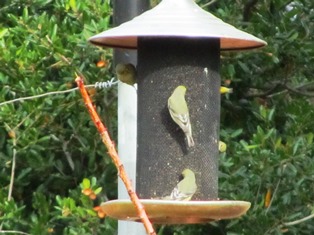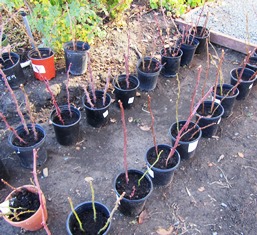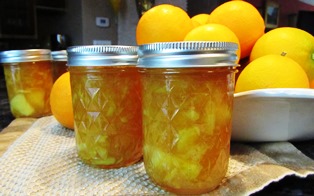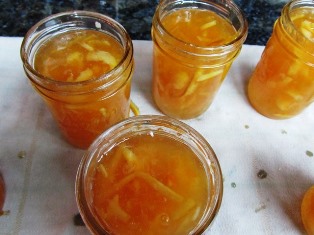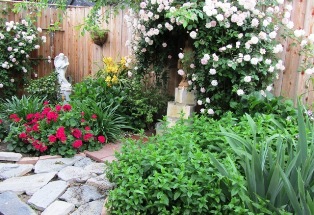Ways to Embrace the Gifts of Winter
As winter approaches, it seems counterintuitive to embrace the cold and dark, especially as we hurry indoors to seek light and warmth. But winter brings the gift of time and circumstances that force us to slow down, rest, reflect, and renew ourselves.
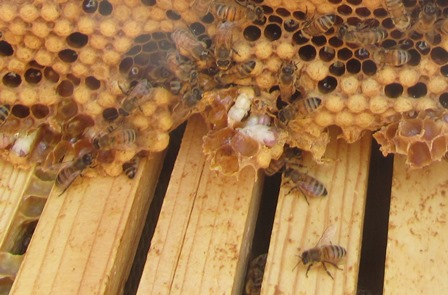
Here on the Henny Penny Farmette, the honey bees remain in their hives until their DNA tells them early spring has arrived. The hens slow their laying of eggs during the cold, dark days of winter. And the soil in the gardens rest as the sap stops flowing in the trees during the months when winter’s chill comes on early and leaves late.
During the current age of telecommuting or arrangements that include some work from home, lying an extra few minutes in bed until the house warms can feel luxurious. After a hearty, healthy breakfast or lunch, a thirty-minute winter stroll across a field, down the road, or to the mailbox and back elevates the feel-good chemicals in your brain, stimulates your sense of well-being, and helps you feel restored.
The winter season is perhaps the best time of year to reflect on impermanence and cyclic change. Start a journal in which to capture your thoughts, hopes, dreams, questions, and ideas about self-evaluation and soul reflection. Learn something new. Sense the charismatic presences around you in nature. Allow your own radiance to flow outward to others.
Winter is a time to think about what you do and don’t want in your life and how you’ll clear the clutter. Is it a person, a habit, a thing? What is it that you want to leave behind in the old year and what do you want to manifest in the coming new year? Before winter is over, make an intention to manifest your deepest desire.

Use the the dark days of winter to reflect on your physical health and mental well-being. What bad habit could you eliminate? What lifestyle change would be healthier for you? How might you gain more self acceptance and self love? What does a picture of great health for your body and mind look like?

wellness, self-improvement, and spirituality
Snuggle up in a chair with a warm throw and read a good book when the winds are howling and the cloud ceiling is low. Reading stimulates the mind. Expand your horizons with an arm-chair travel book. Enjoy a fictive trip through a novel. Solve a mystery. Read about the history of food and try a new recipe. The possibilities for indulging your interests are expansive.
Practice mindfulness. Let new ideas emerge from the depths of your consciousness. Winter is the perfect time and you can do this practice in any setting. Take advantage of the gifts the dark offers.
If you enjoy reading about country living topics, check out my series of cozy mysteries available online and in bookstores everywhere.
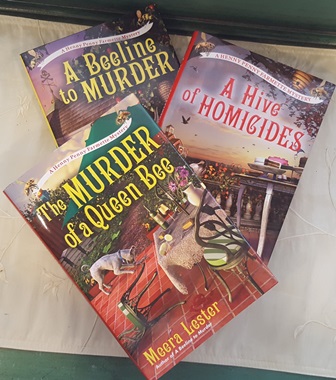
Henny Penny Farmette
De-Bugging My Honeybee Hive Box of Beetles
I’ve been dealing with a beetle problem in my honeybee hive since fall. When my knowledgeable beekeeper neighbor called to suggest opening the hive, I readily agreed.
The dreaded hive beetle–tinier than a honeybee–can destroy a hive. Its destruction isn’t on the bees themselves, but rather the comb, honey, and pollen. As the population of hive beetle increases and the destruction mounts, the bees will abandon the hive.
Previously, my neighbor had used two types of hive beetle traps in my hive–Beetle Bee-Gone was an all-natural, chemical-free sheet that looked like a fabric softener product for the dryer. We had placed this on top of the frames before closing the hive last fall. The other product was a narrow plastic tray inserted between the frames that held vegetable oil.
We discovered that the sheet worked well, trapping lots of hive beetles. But the frame with oil had no beetles. I dumped it. We checked the brood box–and were excited to see it full of unborn babies.
After harvesting eight frames of honey, we reversed the brood box, scraped away the burr comb, and positioned a super on top of the hive box with empty frames for spring honey. Before closing the hive, we inserted two clean sheets of Beetle Bee-Gone.
Today, the bees are active and out foraging for pollen. Flowers are everywhere and the fruit trees in the neighborhood have broken bud. It remains to be seen if the Bay Area gets any more rain or bitterly cold days ahead. Probably by April 1, I’ll hang the swarm catcher and hope to add a new population of bees to my colony.
______________________________________________________________________________
If you enjoy reading about keeping bees, growing heirloom vegetables and fruits, caring for chickens, or self care for healthy living, check out my Henny Penny Farmette series of cozy mysteries: A BEELINE TO MURDER, THE MURDER OF A QUEEN BEE, and HIVE OF HOMICIDES. Click on the URL below. Also see newest nonfiction for healthy living: RITUALS FOR LIFE.
http://tinyurl.com/ya5vhhpm
Harvesting Honey–A Labor of Love
Sitting in the middle of my kitchen is a three-story hive box with thirty frames of honey that needs to be extracted, filtered, and poured into jars.
My apiary is small–just two hives. Taking the honey is quite a labor-intensive activity. But it brings its own kind of joy. As pollinator populations decrease, keeping bees is a small thing I can do for all of us . . . for our planet.
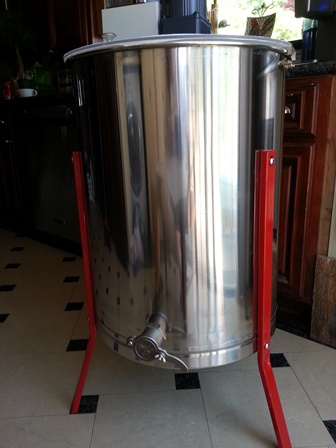
This electric honey extractor holds four frames; honey is spun out through centrifugal force and drains through the spigot
The stainless steel honey extractor, washed and scrubbed, has been pushed over by the oven to make a little space in my already-small kitchen.
Today, I washed the countertops, my stove, and even the sink with hot soapy water and bleach. Then after a thorough wipe-down, I stretched sheets of aluminum foil over the countertop. The extraction process started with four frames.
It’s a simple process. I set the four frames of honey on the foil-covered counter. Using a hot knife, I open the capped cells on both sides of the frames and put them in the honey extractor. Beneath the machine’s spigot, I’ve already positioned a five-gallon bucket with strainer attached. I start the machine on a slow speed and open the spigot.
Each of the five gallon and two-gallon buckets were previously washed and covered with strainers. These are held in place with heavy duty duct tape wrapped around the mouths. Switching out a full bucket for an empty one is easy when the buckets are prepped for use before the extraction starts.
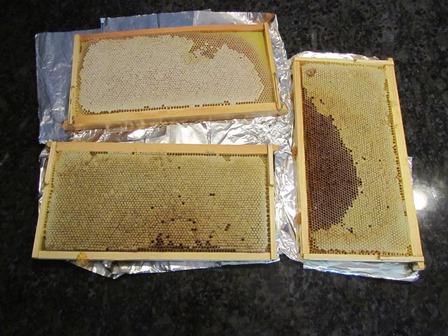
Springtime honey appears golden in the frames whereas autumn honey is often darker (depending on what’s flowering, but often star thistle and eucalyptus, in my area)
I expect a yield of about thirty-five gallons this time. I lost one hive . . . more on that later, but, in all, it looks to be a good honey harvest for our family and friends.
As soon as I extract all the honey, I’ll start bottling it and affixing labels. It’s a process that will take several days to complete.
Tasting, smelling, and seeing all this golden, delicious honey that the bees created warms my heart. When we take care of them, they take care of us. And we always leave plenty of honey in the hives for the bees to eat throughout the winter.
* * *
If you enjoy reading about farmette topics (including gardening, beekeeping, and delicious recipes), check out my Henny Penny Farmette cozy mysteries series from Kensington Publishing.
These novels are chocked full of recipes, farming tips, and sayings as well as a charming cozy mystery.
See, http://tinyurl.com/hxy3s8q
This debut novel launched the Henny Penny Farmette series of mysteries and sold out its first press run. It’s now available in mass market paperback and other formats.
See, http://tinyurl.com/h4kou4g
JUST RELEASED! This, the second cozy mystery in the Henny Penny Farmette series, is garnering great reviews from readers and industry publications.
My books are available through online retailers such as Amazon, Barnes & Noble, Kobo Books, and Walmart as well as from traditional bookstores everywhere.
Yellow-Rumped Warbler and Other Songbirds Act Like It’s Spring
It’s the middle of January but tell that to Mother Nature whose songbirds are singing like it is spring. With our temperatures expected to exceed 70 degrees Fahrenheit in parts of the Bay Area today, the birds are gathering around feeders and fountains and the bees are buzzing about, too.
While having coffee on the patio this morning, I had the privilege of being visited by a variety of winged friends, some seemingly oblivious to me and my camera.
The woodpecker announces himself with the familiar rat-ta-tat-tat while the yellow-rumped warbler and other songbirds hang out in the firethorn bush, in the oak trees, and at several fountains we’ve placed at the rear of our farmette.
There’s a lot of bee traffic today. With warm days forecast for the next week or two, the bees could get the wrong idea and swarm. That would undoubtedly surprise the local backyard bee hobbyists.
So while I love the warm weather–especially when I read about the polar temperatures causing such misery in the Midwest and along the East Coast–like many Californians, I am beginning to worry about the looming possibility of a drought this year and mandatory water rationing.
But, then again, there’s something magical about hearing songbirds trilling in the dead of winter when the fruit trees in the orchard and the roses lining the path to the front door remain soundly asleep. I think I’ll have another cup of coffee and sit for a while longer.
Preparing for an Early Spring
It’s winter. The nights are cold and the early mornings even colder. But here on the farmette, daytime temps are still unseasonably warm for this time of year in Northern California. That makes doing all the winter cleanup and spring preparation chores not only tolerable, but enjoyable.
We’ve pruned all the roses and taken cuttings for propagation of new bushes that we’ll plant around our property. We’ve divided the irises and planted the babies in new beds. Finally, we tackled pruning the fruit trees and imagine how shocked we were to find our Desert Gold peach trees with buds ready to open. The reason must be the warm weather.
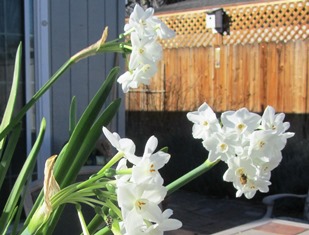
The honeybees are searching for blossoms and finding none, they’re exploring the papaperwhite narcissus on my patio table
The honeybees are searching for flowers in bloom. They’ve flown to the citrus trees that I’ve covered against nighttime freezing temps and are wandering about on the blankets. The French perfume lavender still has some blooms but the bees seem also interested in the paperwhite narcissus blooms that I forced in water between Christmas and New Years Day.
We’ve moved the strawberries to a newly prepared bed in two planter boxes and are revitalizing the soil in the old boxes. Bare root season is around the corner and my husband and I are feeling the pressure to get the garden ready for a new growing season. The days are lengthening and we don’t want an early spring to catch us unprepared. Technically, winter has only just begun but the birds and bees and buds on the trees are suggesting it could be a short winter.
Easy Orange Marmalade
Who can resist the flavors of homemade jams? Whether it embellishes an appetizer of grilled fig and melted goat cheese or is spread upon a fat slice of fresh-baked bread, jam has power to elevate any meal to another level.
Using the seedless oranges growing on our farmette trees, I’m making marmalade. Marmalade made with the oranges ripening this time of year make great additions to holiday gift baskets. I like to add jars of honey, fresh tangerines, nuts, summer jams, and homemade treats.
RECIPE FOR ORANGE MARMALADE
Ingredients:
4 large oranges (preferably a seedless variety)
2 medium lemons
1/2 teaspoon butter (to reduce foaming)
1/8 teaspoon baking soda
6 Tablespoons dry classic pectin
5 1/2 cups sugar
Directions for Preparing the Jars and Canner:
Wash pint jars in the dishwasher or wash the jars and screw rings in hot soapy water, rinse, and drain upside down on paper towels.
Remove the wire rack from the canner and set aside; then, fill the canner half full of water and bring to a simmer.
Directions for Making the Fruit Mixture:
Wash the oranges and lemons.
Peel the fruit, using a vegetable peeler or a sharp paring knife. Discard any seeds and the pithiest parts of the inner peeling as the pith tastes bitter.
Cut the peeled skins into narrow strips.
Pour water into a saucepan.
Add baking soda and strips of peel.
Bring to boil and then reduce the heat, simmering for 20 minutes and stirring as needed.
Cut the fruit into thin quarters.
Add the fruit and juice to the saucepan of simmering peelings, cover, and allow everything to simmer for 10 minutes.
Remove 4 cups of the fruit/peeling/juice mixture and pour into a large saucepan (6 or 8 quart) or stock pot.
Stir in the pectin and add the butter and sugar, mixing well.
Bring to a roiling boil, stirring constantly, for a full minute and then remove from heat, skimming off any foam.
How to Can the Marmalade:
Ladle the fruit mixture into the warm, clean jars, leaving between 1/4 and 1/8 inch space from the top.
Wipe the jar rims before placing the jars on the wire rack of the canner.
Lower the wire rack of jars into the simmering water in the canner.
Make sure the jars are covered by 2 inches of water (add boiling water if necessary).
Cover with lid and boil for 15 to 20 minutes.
Turn off flame, remove the jars of marmalade, and set them onto a towel to cool.
Listen for the popping sound that signals the lids have sealed. Check lids for seal once the jars have cooled by pushing against the center of the lid. If it springs, the jar has not sealed and must be refrigerated. The marmalade will still be good to eat.
Gardens as Sacred Space

Painted with the French words for peace, love, and prayer, the blue trellis serves as a garden focal point
In seed time learn, in harvest teach, in winter enjoy.–William Blake
It feels like winter. No sun after a clear, cold night. The temperature at Lake Tahoe this morning was a level zero. Here on the farmette, the temperature is having trouble pushing out of the 40s. Though bleak outside, there is light and warmth in our little farmhouse. Soup gurgles in the pot on the back burner, and the seed catalogs are close at hand.
Remembering visionary poet William Blake’s admonishment to enjoy winter, I’m trying. The seed catalogs remind me of plants and gardens of my past, the great gardens of the world, and the secret places that all gardens hold–places awaiting discovery or re-discovery. Places that create magic in a garden.
My garden isn’t just a place to cultivate plants; it exists as sacred space, a tranquil retreat. There under trees and amid the roses that I invariably plant, my restless spirit knows its place and can find its peace.
Gardens are so much more than trees and flowers, chimes, statuary, benches, and fountains of flowing water. Far more important than what is visible in a garden is what is not seen . . . but felt.
A garden is a place of presence. One of my favorite writers John O’donohue, Anam Cara and Eternal Echoes) observed, “that presence is alive.” Sacred space beckons us to step away from the cacophony of the world and enter Kairos or God’s time to dream, create, pray, love, nuture Self, and experience the wild presences of Nature.
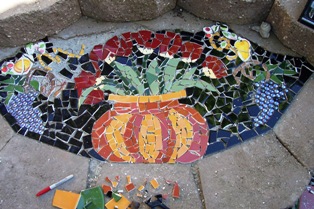
The best gardens always have a little surprise; this is a garden step I created some years ago while writing my Adventures in Mosaic book
We step in and out of the garden, a living and ever-changing landscape, but it is only when we linger in the landscape that we are embraced by the unseen–what O’Donohue referred to as silent and indirect presences.
A garden nourishes and nurtures. It was to the garden I turned after losing five family members in five years; my mother and my 46-year-old husband were the last to go. I hid myself away in our garden, turned on the water, and allowed my own tears to flow until none were left.
Later, I spent hours in the garden, mourning my loss, remembering my dreams, re-imaging my future, and praying for my aching heart to heal. Relief came as I created pique assiette mosaics and photographed them for a book to be published.
From broken china pieces and colored glass, I created a child’s tea table. When a local teacher told me about a girl in her class whose father needed a heart transplant and had no money for Christmas presents, I gave the table to his little girl.
In my garden, I found healing and wholeness and strength to again step into life. The power of sacred space can do that. It can uplift your spirit and nourish you with light and warmth when all seems so terribly bleak. Best of all, garden memories are bearers of light and joy, nourishing your spirit even on the darkest, coldest days of winter.
 Facebook
Facebook Goodreads
Goodreads LinkedIn
LinkedIn Meera Lester
Meera Lester Twitter
Twitter




